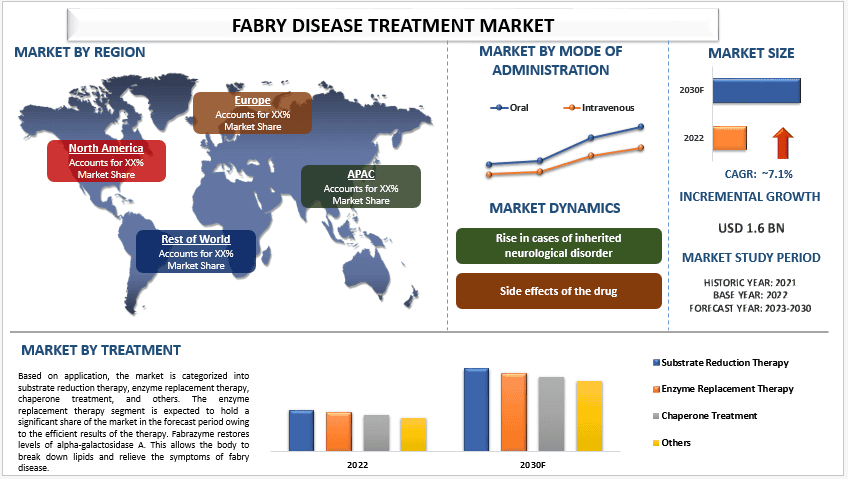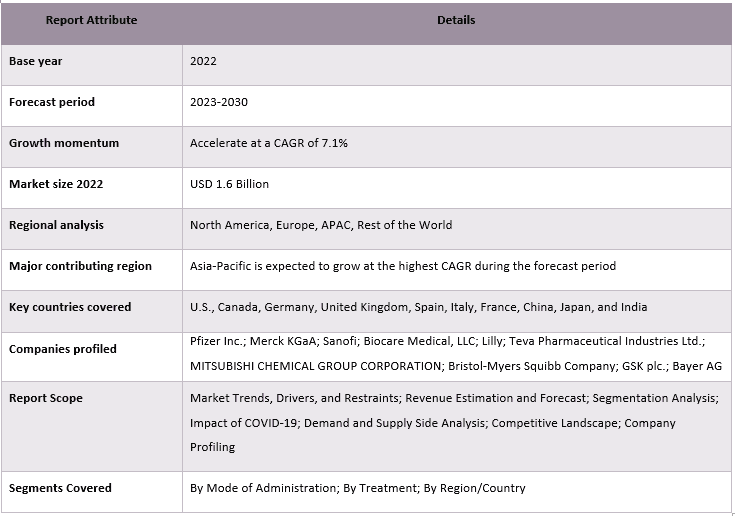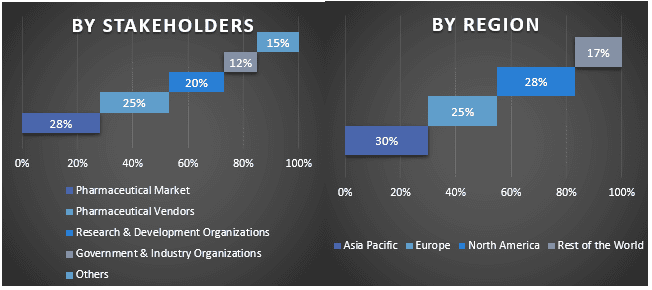- Home
- About Us
- Industry
- Services
- Reading
- Contact Us
Fabry Disease Treatment Market: Current Analysis and Forecast (2023-2030)
Emphasis on Mode of Administration (Oral and Intravenous); Treatment (Substrate Reduction Therapy, Enzyme Replacement Therapy, Chaperone Treatment, and Others); and Region/Country

The Global Fabry Disease Treatment Market was valued at USD 1.6 Billion in 2022 and is expected to grow a CAGR of 7.1% during the forecast period (2023-2030). Fabry disease treatment services mainly gained prominence due to the increased number of inherited disorders globally. For instance, according to the Faculty of Public Health, at birth, while individually rare, collectively genetic disorders are relatively common, with a combined prevalence of around 1-2% in the UK. In addition to this, investments in healthcare departments as well as government awareness programs regarding controlling the inheritance of such neurological disorders by initiating more diagnostic tests have increased significantly in recent years, which are the key factors that are creating opportunities for the market. Many other factors were identified that helped in propelling the market in the forecast period such as the surge in government initiatives regarding genetic disorders are also driving the growth of the market. For instance, the draft National Policy for Rare Diseases was finalized by the Government of India and placed in the public domain in January 2020 inviting views from all the stakeholders, the general public, organizations, states, and union territories.
Pfizer Inc.; Merck KGaA; Sanofi; Biocare Medical, LLC; Lilly; Teva Pharmaceutical Industries Ltd.; MITSUBISHI CHEMICAL GROUP CORPORATION; Bristol-Myers Squibb Company; GSK plc.; Bayer AG are some of the key players in the market. Several M&As along with partnerships have been undertaken by these players to facilitate customers with hi-tech and innovative products/technologies.
Insights Presented in the Report
“Amongst mode of administration, intravenous category to witness higher CAGR during the forecast period.”
Based on the mode of administration, the market is bifurcated into oral and intravenous segments. The intravenous segment is expected to grow with a high CAGR during the forecast period as a faster mode of action and effectiveness. For instance, according to the National Library of Medicine’s article in February 2023, the intravenous mode of drug administration provides the most complete drug availability with negligible delay. Also, this mode is comfortable for patients who face difficulty in ingesting medicines orally. Thus, the intravenous category is expected to witness higher CAGR during the forecast period.
“Amongst treatment, chaperone treatment held a significant share in the market in 2022”
Based on treatment, the market is categorized into substrate reduction therapy, enzyme replacement therapy, chaperone treatment, and others. The chaperone treatment segment dominated the market in 2022 owing to the innovative and very safe outcomes of this therapy. Clinical data proved that oral chaperone therapy decreased and stabilized kidney function in most patients globally which is a driving factor for this segment. Owing to the above reasons, the chaperone treatment segment held a significant share of the market in the year 2022.
“Amongst regions, APAC held higher CAGR during the forecast period”
APAC is expected to grow with a high CAGR during the forecast period. Several factors such as a surge in the geriatric population in the region, the development of a wide range of therapeutics with Fabry disease treatment, and enhanced accessibility of pharmaceutical products are driving the market’s growth during the forecast period. Further, the increase in incidences of inherited neurological disorders in several parts of the region, the presence of key generic pharmaceutical companies in the region, and the surge in government initiatives and special communities are also positively impacting the market’s growth. There have been significant improvisations and enhancements in fabry disease treatment in the region. For example, in November 2023, India’s Rajiv Gandhi Centre for Biotechnology announced that it would assist all districts, taluk hospitals, and family groups in Kerala to identify rare pediatric genetic diseases. Hence, APAC is supposed to witness a higher CAGR during the forecast period.
Fabry Disease Treatment Market Report Coverage

Reasons to buy this report:
- The study includes market sizing and forecasting analysis validated by authenticated key industry experts.
- The report presents a quick review of overall industry performance at one glance.
- The report covers an in-depth analysis of prominent industry peers with a primary focus on key business financials, product portfolio, expansion strategies, and recent developments.
- Detailed examination of drivers, restraints, key trends, and opportunities prevailing in the industry.
- The study comprehensively covers the market across different segments.
- Deep dive regional level analysis of the industry.
Customization Options:
The global fabry disease treatment market can further be customized as per the requirement or any other market segment. Besides this, UMI understands that you may have your own business needs, hence feel free to connect with us to get a report that completely suits your requirements.
Table of Content
Research Methodology for the Fabry Disease Treatment Market Analysis (2023-2030)
Analyzing the historical market, estimating the current market, and forecasting the future market of the global fabry disease treatment market were the three major steps undertaken to create and analyze the adoption of fabry disease treatment in major regions globally. Exhaustive secondary research was conducted to collect the historical market numbers and estimate the current market size. Secondly, to validate these insights, numerous findings and assumptions were taken into consideration. Moreover, exhaustive primary interviews were also conducted, with industry experts across the value chain of the global fabry disease treatment market. Post assumption and validation of market numbers through primary interviews, we employed a top-down/bottom-up approach to forecasting the complete market size. Thereafter, market breakdown and data triangulation methods were adopted to estimate and analyze the market size of segments and sub-segments of the industry pertains to. Detailed methodology is explained below:
Analysis of Historical Market Size
Step 1: In-Depth Study of Secondary Sources:
Detail secondary study was conducted to obtain the historical market size of the fabry disease treatment market through company internal sources such as annual reports & financial statements, performance presentations, press releases, etc., and external sources including journals, news & articles, government publications, competitor publications, sector reports, third-party database, and other credible publications.
Step 2: Market Segmentation:
After obtaining the historical market size of the fabry disease treatment market, we conducted a detailed secondary analysis to gather historical market insights and share for different segments & sub-segments for major regions. Major segments are included in the report as mode of administration, treatment, and regions. Further country-level analyses were conducted to evaluate the overall adoption of testing models in that region.
Step 3: Factor Analysis:
After acquiring the historical market size of different segments and sub-segments, we conducted a detailed factor analysis to estimate the current market size of the fabry disease treatment market. Further, we conducted factor analysis using dependent and independent variables such as mode of administration, treatment, and regions of fabry disease treatment. A thorough analysis was conducted for demand and supply-side scenarios considering top partnerships, mergers and acquisitions, business expansion, and product launches in the fabry disease treatment market sector across the globe.
Current Market Size Estimate & Forecast
Current Market Sizing: Based on actionable insights from the above 3 steps, we arrived at the current market size, key players in the global fabry disease treatment market, and market shares of the segments. All the required percentage shares split and market breakdowns were determined using the above-mentioned secondary approach and were verified through primary interviews.
Estimation & Forecasting: For market estimation and forecast, weights were assigned to different factors including drivers & trends, restraints, and opportunities available for the stakeholders. After analyzing these factors, relevant forecasting techniques i.e., the top-down/bottom-up approach were applied to arrive at the market forecast for 2030 00for different segments and sub-segments across the major markets globally. The research methodology adopted to estimate the market size encompasses:
- The industry’s market size, in terms of revenue (USD) and the adoption rate of the fabry disease treatment market across the major markets domestically
- All percentage shares, splits, and breakdowns of market segments and sub-segments
- Key players in the global fabry disease treatment market in terms of products offered. Also, the growth strategies adopted by these players to compete in the fast-growing market
Market Size and Share Validation
Primary Research: In-depth interviews were conducted with the Key Opinion Leaders (KOLs) including Top Level Executives (CXO/VPs, Sales Head, Marketing Head, Operational Head, Regional Head, Country Head, etc.) across major regions. Primary research findings were then summarized, and statistical analysis was performed to prove the stated hypothesis. Inputs from primary research were consolidated with secondary findings, hence turning information into actionable insights.
Split of Primary Participants in Different Regions

Market Engineering
The data triangulation technique was employed to complete the overall market estimation and to arrive at precise statistical numbers for each segment and sub-segment of the global fabry disease treatment market. Data was split into several segments & sub-segments post studying various parameters and trends in the areas of mode of administration, treatment, and regions in the global fabry disease treatment market.
The main objective of the Global Fabry Disease Treatment Market Study
The current & future market trends of the global fabry disease treatment market were pinpointed in the study. Investors can gain strategic insights to base their discretion for investments on the qualitative and quantitative analysis performed in the study. Current and future market trends determined the overall attractiveness of the market at a regional level, providing a platform for the industrial participant to exploit the untapped market to benefit from a first-mover advantage. Other quantitative goals of the studies include:
- Analyze the current and forecast market size of the fabry disease treatment market in terms of value (USD). Also, analyze the current and forecast market size of different segments and sub-segments
- Segments in the study include areas of mode of administration, treatment, and regions
- Define and analyze the regulatory framework for the fabry disease treatment industry.
- Analyze the value chain involved with the presence of various intermediaries, along with analyzing customer and competitor behaviors of the industry.
- Analyze the current and forecast market size of the fabry disease treatment market for the major region.
- Major countries of regions studied in the report include Asia Pacific, Europe, North America, and the Rest of the World.
- Company profiles of the fabry disease treatment market and the growth strategies adopted by the market players to sustain in the fast-growing market
- Deep dive regional level analysis of the industry
Frequently Asked Questions FAQs
Q1: What is the current market size and growth potential of the fabry disease treatment market?
Q2: What are the driving factors for the growth of the fabry disease treatment market?
Q3: Which segment has the largest share of the fabry disease treatment market by mode of administration?
Q4: What are the emerging technologies and trends in the fabry disease treatment market?
Q5: Which region will dominate the fabry disease treatment market?
Q6: Who are the key players operating in the fabry disease treatment market?
Related Reports
Customers who bought this item also bought










